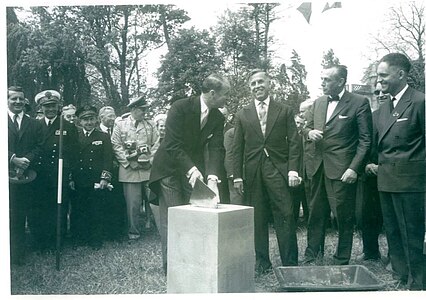Airborne Museum (Sainte-Mère-Église)
This article has multiple issues. Please help improve it or discuss these issues on the talk page. (Learn how and when to remove these messages)
|
 | |
| Established | 1964 |
|---|---|
| Location | Sainte-Mère-Église 14, rue Eisenhower 50480 |
| Type | War museum |
| Collections | Military exhibits dealing with the 82nd and 101 Airborne Divisions, U.S. Army |
| Visitors | 180 922 visitors in 2011 |
| Director | Magali Mallet |
| President | Marc Lefèvre |
| Website | http://www.airborne-museum.org |
The Airborne Museum (Musée Airborne) is a French museum dedicated to the memory of American paratroopers of the 82nd and 101st airborne divisions who were dropped into Normandy in the night of June 5–6, 1944. The museum is located in Sainte-Mère-Eglise.
History
The museum was chartered under a 1901 law, and opened its doors in 1964 with the help of donations from both residents and veterans. The Museum is located in Sainte-Mere-Eglise, in the La Manche region of Normandy, which is close to the D-Day landing beaches. Sainte-Mere-Eglise became famous because of the paratrooper John Steele, whose parachute snagged on the belfry of the church on June 6, 1944, leaving him suspended in the air. The aim of the museum is to honor the American airborne troops of the 82nd and 101st divisions.
The museum
In 1964, to honor the liberators' memory, Dr. Masselin, General Ridgway (Commanding General of the 82nd in 1944) and General Gavin inaugurated the museum on the 20th anniversary of D-Day. The building contains a parachute with an authentic WACO glider, the only example in France. Visitors gain access inside the glider next to the soldiers, ready for their flight. These aircraft without engine had a role of great importance. The helped to take on board Gliders, vehicles, ammunition and other military equipment and rations to feed the soldiers. It also contains a wide variety of antique items that bring the viewer in wartime. This building has been constructed at the same place of the house which burned in the night of June 5, 1944 as recorded in the famous movie The Longest Day. For the 20th anniversary of the Airborne Museum, General James M.Gavin did the honor of his presence at the museum.

In 1983, in presence of Bob Murphy (pathfinder of the 82nd Airborne Division), took place the inauguration of a second parachute-shaped building which covers a C-47. This plane was involved in airdrop operations on Sainte-Mere-Eglise in the night of June 5 to 6, 1944 and in the missions that followed. This building allows the public to assist to the preparations for the biggest military operation. Visitors find themselves in England, June 5, 1944 at the bottom of a real C-47. They also can observe the different recruits from twentieth century accompanied by General Eisenhower before D-Day and the Battle of Normandy. The public is invited in the projection room to watch for 20 minutes a film named Combat pour la Liberté (Fight for Freedom) available in many languages and which traces life during German occupation and the liberation of Sainte-Mère-Eglise and the Cotentin.
For the 70th anniversary of D-Day, the third building named Operation Neptune, opens its doors to the public. The latter was the first assault phase of Overlord plan (code name for the Battle of Normandy). The building was inaugurated in presence of veterans of World War II. Covering an area of 1200m², Operation Neptune is composed of informative rooms and immersive rooms which, thanks to the very realistic scenography, allows visitors live D-Day experience. The visitor is first invited to board a plane C-47, in England on June 5, 1944. Then unfold the Battle of Sainte-Mère-Eglise, fighting in the marshes and the fight for bridges before the Battle of the hedgerows. The tour ends with an exhibition hall in which are evocated temporary cemeteries around Sainte-Mere-Eglise, changing outfits paratroopers, operations that followed the Normandy landings (Provence, Belgium, Netherlands...), the French-German reconciliation...

In May 2015, work was begun on a fourth building that will be annexed to Operation Neptune, the center of a Franco-American Ronald Reagan Conference center. In 2016 the Airborne Museum will open this new structure, which will hold temporary exhibitions, lectures, seminars and will feature a large cinema auditorium.
Collections
The museum holds more than 10,000 items, which include a Waco Glider, a C-47 cargo plane, General Gavin’s helmet, General Ridgeway’s jump boots, General Collins’s jacket and John Steele’s decorations. The items date to World War II, when many of them were used by paratroopers who jumped into Sainte-Mère-Eglise during the Battle of Normandy. The museum has mostly American equipment, but visitors also see replicas of German military equipment from the twentieth century. The Airborne Museum has at least a hundred uniformed dummies to present uniforms and equipment of the period.
Gallery
-
The cornerstone of the first building being placed by James M. Gavin, with Mayor Jean Masselin of Sainte Mère Eglise at far right, June 6, 1982
-
Interior exhibit showing models of U.S. soldiers and equipment
-
Entryway to a C-47 aircraft




